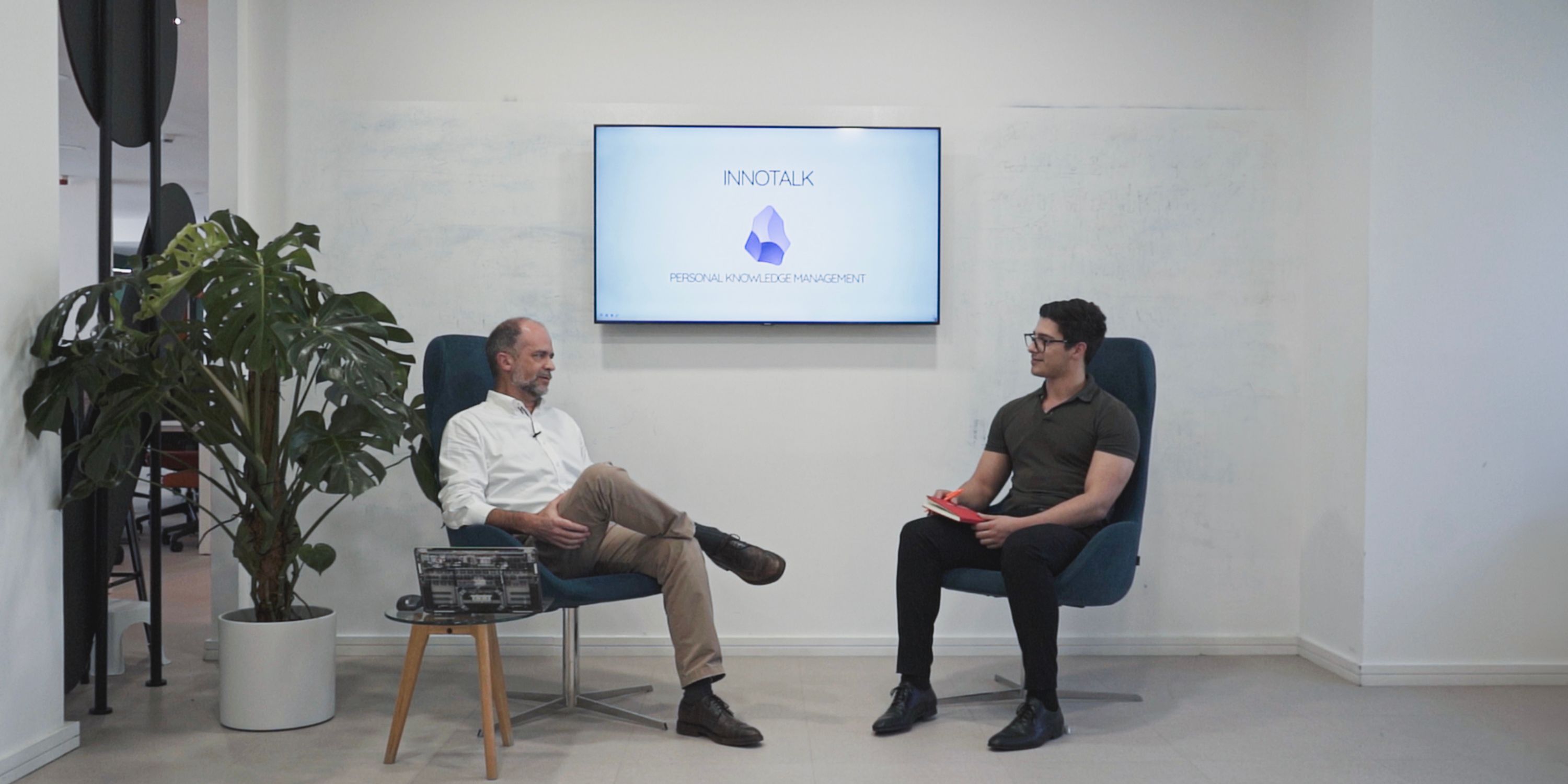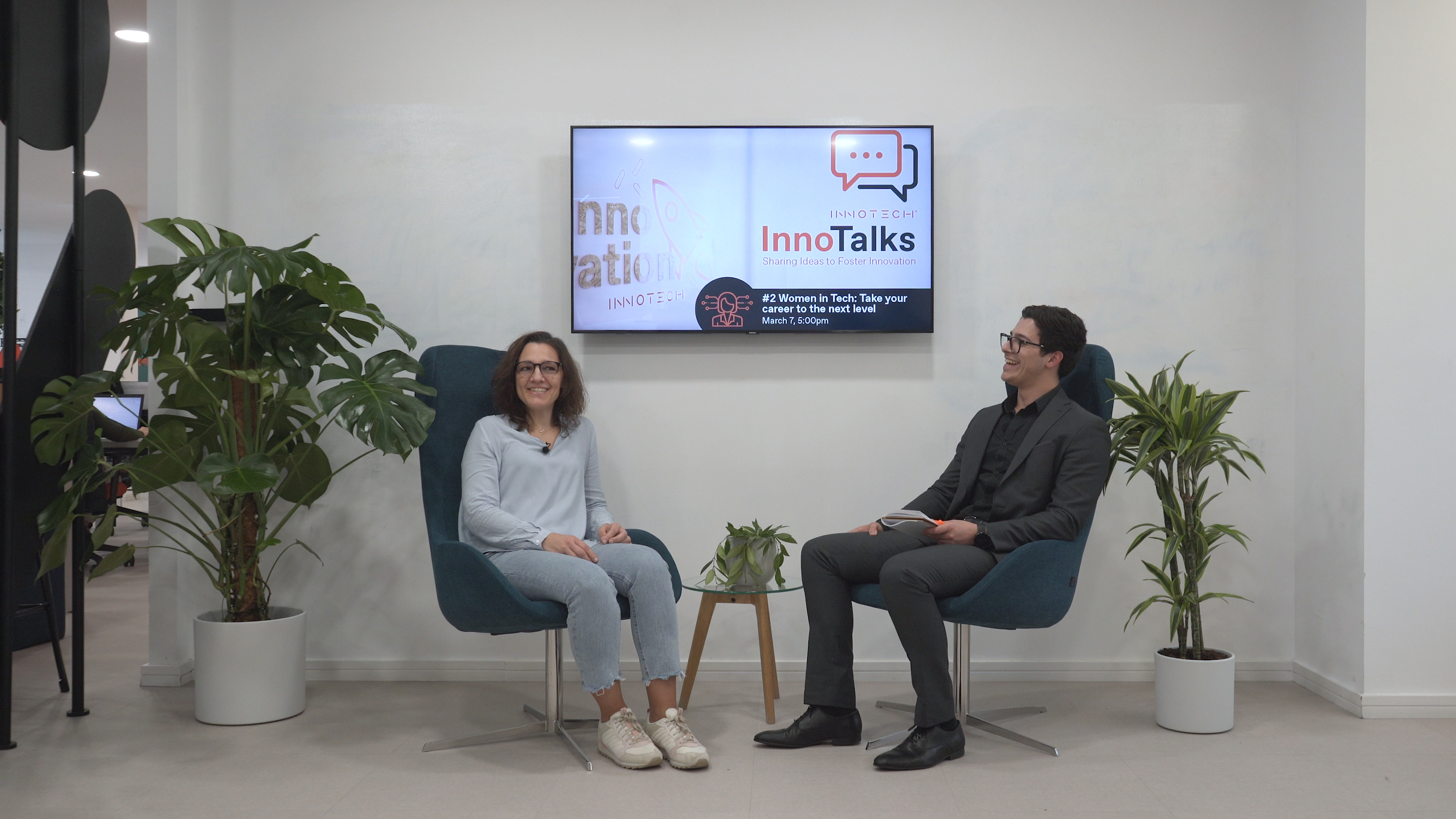In the last InnoTalk we had the pleasure of listening to Michaël Memeteau’s experience with Personal Knowledge Management systems, namely Obsidian.
Michaël is a Product Owner and Solutions Architect at InnoTech, and he started using Obsidian as a tool to access the information he has acquired during his career.
In the InnoTalk Michaël provided us with a walkthrough his Obsidian platform. In this article we will dive into what is Personal Knowledge Management (PKM) and give an overview of the Obsidian system.
What are personal knowledge management systems?
Personal knowledge management systems are tools and processes that help individuals deliberately and systematically organize their personal knowledge and information assets.
Personal knowledge management systems are intended to help people become more effective at work, learning, and life. They do so by making it easier to store, and subsequently find, reuse, and share the knowledge they need when they need it.
PKM involves capturing information and ideas, processing them to add context, incubating them, and then using them to create new things.
In summary, personal knowledge management systems are personalized tools and processes that help people better organize, access, and leverage their own knowledge and information.
The 5Cs of Personal Knowledge Management:
Personal kowledge management is based on five key components or “5Cs”, which are:
Capture: The process of collecting and storing information, ideas, and knowledge from various sources, such as notes, documents, web pages, emails, etc.
Curate: The act of organizing, structuring, and adding context to the captured information to make it more meaningful and useful. This may involve tagging, categorizing, and linking related pieces of information.
Connect: Identifying relationships and connections between different pieces of information to generate new insights and ideas. This could involve creating mind maps, visualizations, or other tools to see how information is linked.
Cultivate: Regularly reviewing, refining, and updating the PKM system to ensure it remains relevant and aligned with one’s evolving needs and goals. This may involve pruning outdated information, experimenting with new tools, or rethinking organizational structures.
Create: Using the organized knowledge in the PKM system to generate new ideas, solutions, and outputs, such as reports, presentations, or creative projects. The goal is to leverage the stored information to become more productive and innovative.
In summary, the 5Cs of personal knowledge management are Capture, Curate, Connect, Cultivate, and Create – the key processes that help individuals effectively manage their personal knowledge and information assets.
Notion vs Obsidian – what to chosse as your PKM system?
There are several personal knowledge management tools to choose from, but Notion and Obsidian are some of the best known ones. Still, there are some key reasons to compare between tools to make a good, informed decision. For example, when it comes to Notion vs Obsidian, these are the distinctive factors:
Focus:
Obsidian is primarily designed for personal knowledge management, focusing on note-taking, and creating a network of interconnected notes. It emphasizes data privacy by storing notes locally on your device and supports offline access.
Notion, on the other hand, is a more versatile tool that can be used for note-taking, project management, knowledge sharing, collaboration, and more. It offers a broader range of features, including databases, calendars, and collaboration tools, making it suitable for project management and team collaboration alongside personal note-taking.
Customization:
Obsidian stands out for its deep customization capabilities, which are especially appealing if you enjoy tailoring your note-taking environment. Its extensive plugin ecosystem allows you to add various features and extend the app’s functionality.
Notion also offers customization options, but they are more limited compared to Obsidian. Notion’s user-friendly interface and the ability to experiment with different structures make it easier to adapt to your needs.
Collaboration:
Obsidian does not have built-in collaboration features, requiring users to set up additional solutions for sharing notes with others. This can be done by creating a vault and uploading it to a cloud file storage service.
Notion, however, offers real-time collaboration features, making it easier to work with others on projects and share documents.
Pricing:
Obsidian offers a free desktop app with full functionality, but you’ll need to pay for syncing across devices or publishing to the web.
Notion also offers a free plan, but it’s more limited compared to Obsidian. The free plan includes limited blocks, and you’ll need to upgrade to a paid plan for more features and collaboration capabilities.
Learning Curve:
Obsidian’s interface can be more challenging to learn for those accustomed to more visual note-taking tools. However, once you get used to the Markdown syntax and linking notes, it becomes more intuitive.
Notion’s interface is generally considered more user-friendly, especially for those familiar with other productivity tools. The ability to experiment with different structures and the variety of content types make it easier to adapt to your needs.
Conclusion:
Ultimately, the choice between Obsidian and Notion depends on your specific needs and preferences. If you prioritize data privacy, customization, and a more focused note-taking experience, Obsidian might be the better choice. If you need a more versatile tool for collaboration, project management, and content creation, Notion could be the way to go.
An overview of Obsidian:
Obsidian is the ideal PKM system for those who value data privacy, prefer a more streamlined note-taking experience, and are willing to invest time in customizing their tool. It’s perfect for personal knowledge management and academic research, but it can also be used for project management. This overview of Obsidian is based on Michaël’s experience with the tool.
Managing Day-to-Day Activities:
- The daily log alloes you to keep track of your day with Markdown-based logging, maintaining everything in text format.
- Hyperlinks allow you to easily navigate through linked content for seamless access to related information.
- The tagging and folder structure are essential for organizing your notes efficiently using tags and folders, enhancing structural clarity.
- Web clipping is a way to save web content directly into Obsidian for future reference and easy retrieval.
- When it comes to using Obsidian in meetings, you can share meeting notes and utilize quick sharing options for PDFs and Word documents.
- Creating presentations is easier with Obsidian’s capabilities to craft presentations, offering a dynamic and interactive approach to communication.
Project Management:
- Project status management allows you to manage project statuses effectively, illustrated through AutoSeverity’s project status example.
- Backlog management is a good way to optimize backlog management using Kanban boards, ensuring smooth workflow organization.
- Specialized diagrams can create domain-specific diagrams such as BPMN to visualize processes accurately.
- Obsidian allows you to annotate PDFs seamlessly within Obsidian for enhanced collaboration and document management.
- You can utilize graphs to visualize complex connections and conduct thorough research within Obsidian.
- Workspaces allow you to navigate through different project contexts effortlessly, maintaining focus and productivity.
- Extract valuable insights by listing all PDFs contained within specific folders using Obsidian’s Dataview feature.
- With Obsidian you can incorporate metadata like APACHE II for enhanced organization and categorization.
- Running code is one of the advantages of using Obsidian. Execute Python code snippets directly within Obsidian for streamlined workflow automation and analysis.
Integration with AI
- Audio Transcription: Leverage AI capabilities to transcribe meeting audio, facilitating efficient note-taking and documentation.
- Content Creation: Generate project personas and create content effortlessly within Obsidian.
- Translations: Seamlessly translate content between English and Portuguese to support multilingual collaboration.
- Autocomplete: Enhance productivity with Obsidian’s autocomplete feature, providing quick suggestions for text completion.
- Local AI Engine Compatibility: Enjoy compatibility with local AI engines, ensuring uninterrupted workflow even without internet access.


